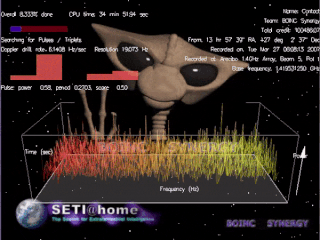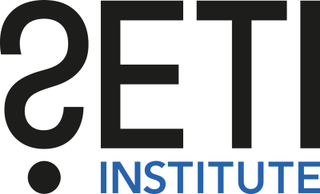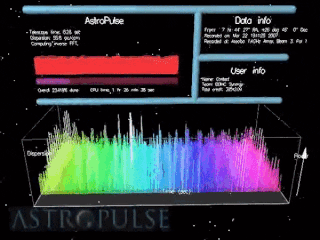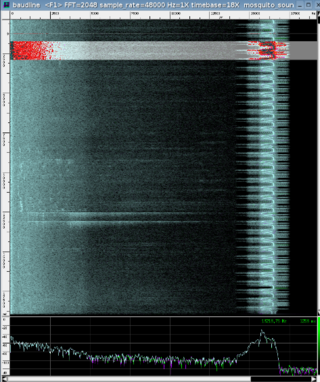The search for extraterrestrial intelligence (SETI) is a collective term for scientific searches for intelligent extraterrestrial life, for example, monitoring electromagnetic radiation for signs of transmissions from civilizations on other planets.

Contact is a 1985 hard science fiction novel by American scientist Carl Sagan. It deals with the theme of contact between humanity and a more technologically advanced extraterrestrial life form. It ranked No. 7 on the 1985 U.S. bestseller list. The only full work of fiction published by Sagan, the novel originated as a screenplay by Sagan and Ann Druyan in 1979; when development of the film stalled, Sagan decided to convert the stalled film into a novel. The film concept was subsequently revived and eventually released in 1997 as the film Contact starring Jodie Foster.

SETI@home is a project of the Berkeley SETI Research Center to analyze radio signals with the aim of searching for signs of extraterrestrial intelligence. Until March 2020, it was run as an Internet-based public volunteer computing project that employed the BOINC software platform. It is hosted by the Space Sciences Laboratory at the University of California, Berkeley, and is one of many activities undertaken as part of the worldwide SETI effort.

Jill Cornell Tarter is an American astronomer best known for her work on the search for extraterrestrial intelligence (SETI). Tarter is the former director of the Center for SETI Research, holding the Bernard M. Oliver Chair for SETI at the SETI Institute. In 2002, Discover magazine recognized her as one of the 50 most important women in science.

The SETI Institute is a not-for-profit research organization incorporated in 1984 whose mission is to explore, understand, and explain the origin and nature of life in the universe, and to use this knowledge to inspire and guide present and future generations, sharing knowledge with the public, the press, and the government. SETI stands for the "search for extraterrestrial intelligence".

Project Ozma was a search for extraterrestrial intelligence (SETI) experiment started in 1960 by Cornell University astronomer Frank Drake, at the National Radio Astronomy Observatory, Green Bank at Green Bank, West Virginia. The object of the experiment was to search for signs of life in distant planetary systems through interstellar radio waves. The program was named after Princess Ozma, ruler of the fictional land of Oz, inspired by L. Frank Baum's supposed communication with Oz by radio to learn of the events in the books taking place after The Emerald City of Oz. The search was publicized in articles in the popular media of the time, such as Time magazine and was described as the first modern SETI experiment.

The Wow! signal was a strong narrowband radio signal detected on August 15, 1977, by Ohio State University's Big Ear radio telescope in the United States, then used to support the search for extraterrestrial intelligence. The signal appeared to come from the direction of the constellation Sagittarius and bore expected hallmarks of extraterrestrial origin.

The Allen Telescope Array (ATA), formerly known as the One Hectare Telescope (1hT), is a radio telescope array dedicated to astronomical observations and a simultaneous search for extraterrestrial intelligence (SETI). The array is situated at the Hat Creek Radio Observatory in Shasta County, 290 miles (470 km) northeast of San Francisco, California.

Astropulse is a volunteer computing project to search for primordial black holes, pulsars, and extraterrestrial intelligence (ETI). Volunteer resources are harnessed through Berkeley Open Infrastructure for Network Computing (BOINC) platform. In 1999, the Space Sciences Laboratory launched SETI@home, which would rely on massively parallel computation on desktop computers scattered around the world. SETI@home utilizes recorded data from the Arecibo radio telescope and searches for narrow-bandwidth radio signals from space, signifying the presence of extraterrestrial technology. It was soon recognized that this same data might be scoured for other signals of value to the astronomy and physics community.

The baudline time-frequency browser is a signal analysis tool designed for scientific visualization. It runs on several Unix-like operating systems under the X Window System. Baudline is useful for real-time spectral monitoring, collected signals analysis, generating test signals, making distortion measurements, and playing back audio files.
The High Resolution Microwave Survey (HRMS) was a NASA project that was to scan ten million frequencies using radio telescopes. A decade in the making, the objective was to find transmissions from alien intelligences. The primary point of observation for the project was the Arecibo Ionospheric Observatory in Puerto Rico. The project began in October 1992 with SETI researcher Jill Tarter on board. However, one year later, first-term Nevada Senator Richard Bryan was responsible for removing funding for the project.
SERENDIP is a Search for Extra-Terrestrial Intelligence (SETI) program originated by the Berkeley SETI Research Center at the University of California, Berkeley.

Robert Hansen Gray was an American data analyst, author, and astronomer, and author of The Elusive Wow: Searching for Extraterrestrial Intelligence.
Open SonATA stands for Open SETI on the Allen Telescope Array and is the open source version of the software are used for signal detection by the SETI Institute on the Allen Telescope Array (ATA). The software currently runs on Linux and macOS operating systems and is intended to be ported to multiple platforms. The Allen Telescope Array uses the OpenSUSE operating system on the SonATA computers.
SETILive was an online project of Zooniverse that utilized live participants to analyze radio telescope data in real time to recognize patterns to find extraterrestrial intelligences (ETI's). The project ceased live operations on 12 October 2014, but still allows archival analysis.

SETIcon was a public convention organized by the SETI Institute and held twice in Santa Clara, California. It was an interdisciplinary conference, with talks focusing on a wide range of issues related to the search for extraterrestrial intelligence (SETI). The programs included panels with prominent scientists from NASA and SETI; talks by science fiction writers, artists, and actors; and panels to explore controversial issues and compare perspectives. The sessions were non-technical and meant to increase awareness, interest, and funding for the SETI Institute. The convention attracted professional scientists, educators, space enthusiasts, and science fiction fans. Astronomical tattoos were not uncommon among attendees.
Thomas Pierson was founder and CEO of the SETI Institute, a non-profit institute conducting research in Astrobiology.

Breakthrough Listen is a project to search for intelligent extraterrestrial communications in the Universe. With $100 million in funding and thousands of hours of dedicated telescope time on state-of-the-art facilities, it is the most comprehensive search for alien communications to date. The project began in January 2016, and is expected to continue for 10 years. It is a component of Yuri Milner's Breakthrough Initiatives program. The science program for Breakthrough Listen is based at Berkeley SETI Research Center, located in the Astronomy Department at the University of California, Berkeley.

The Berkeley SETI Research Center (BSRC) conducts experiments searching for optical and electromagnetic transmissions from intelligent extraterrestrial civilizations. The center is based at the University of California, Berkeley.

The Transient Array Radio Telescope (TART) is a low-cost open-source array radio telescope consisting of 24 all-sky GNSS receivers operating at the L1-band (1.575 GHz). TART was designed as an all-sky survey instrument for detecting radio bursts, as well as providing a test-bed for the development of new synthesis imaging and calibration algorithms. All of the telescope hardware including radio receivers, correlators and operating software are open source. A TART-2 radio-telescope can be built for approximately 1000 Euros, and the telescope antenna array requires 4m x 4m area for deployment.












